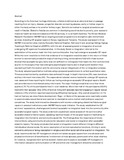| dc.description.abstract | According to the American heritage dictionary, a fistula is defined as an abnormal duct or passage resulting from an injury, disease, congenital disorder connecting abscess, cavity or hollow organ to either the body surface or to another hollow organ. Sometimes medical or surgical procedures can result in fistulae. Obstetric fistulae are common in developing countries due to poverty, poor access to maternal health services and absence of EmOC services, in rural health facilities. The African Medical Research Foundation AMREF has an ongoing outreach programme to strengthen safe motherhood services, including OF surgical repairs in Kenya, Uganda and Tanzania. This study was based in three AMREF intervention sites; namely Kenyatta National Hospital, Kisii Level 5 and Jaramogi Odinga Oginga Teaching & Referral Hospital (JOORTH), with the aim of assessing social re-integration of women undergoing OF repairs at the selected sites.
In this study Social re-integration referred to the assimilation of the women back into their communities after they had undergone successful OF repair. While the norm would be to think that evidence of re-integration would be seen in the return of these women to economically productive ways of earning a living, conversations held with these women showed that successful surgery alone was not sufficient to reintegrate them back into their communities as prior to the surgery they had undergone psychological trauma due to stigma and isolation thus counseling of both the women and the community was an integral part of the re-integration process. The study adopted quantitative methods using a prepared questionnaire to collect quantitative data. This was complimented by qualitative data collected through in depth interviews (IDI), case narratives and key informant interviews (KII). The respondents included women booked to undergo OF repairs as new cases and those reporting for follow up, having undergone successful OF surgical repairs. Health care providers were interviewed as key informants.
The major findings reveal that more than three quarters (79.7%) of the participants lived in rural residence. More than half of the participants (58.8%) lived with their spouses. Only (35%) of women living with spouses reported engaging in regular sexual relations (15%) of whom reported experiencing difficulties having sex. Only a small proportion (3.1%) had not had any sex since fistula development.
Page | xii
Some of the spouses were reportedly unable to accommodate sexual denial and resorted to clandestine extra-marital relationships or acquired concubines.
The study held interactive discussions with women undergoing obstetrical fistula surgical repairs in selected institutions under AMREF fistula repair initiative. The study established the OF survivors’ expectations, challenges and levels of successful re-integration back into the community after successful surgical repairs. The study undertook a systematic social analysis of the survivors after successful obstetric fistula repairs, assessing reported impact of the surgical repairs in facilitating re-integration into the family and community social life. The findings show the importance of timely interventions, using community structures for education and social re-integration after successful obstetric repairs.
The study concludes that social re-integration meant different things to different individuals at diverse levels. For some resumption of normal reproductive functions, thriving in socio-economic ventures or being reaccepted in religious and other social activities was full re-integration. The study recommends that OF management should not isolate surgical repairs from overall social and physical environment of beneficiaries. Involvement of male spouses, parents and other close relatives, for instance, recognizes them as final decision makers and impacts on successful OF management. Information education communication on OF prevention and management should be extended to younger women and girls in institutions of learning. Affirmative action should be put in place to ensure women are empowered to seek competent maternal and delivery services to avoid the risk of developing fistula. Medical personnel could team up with professionally trained counselors, specialized in handling fistula clients and their families, to complement social re-integration back into society. | en |


